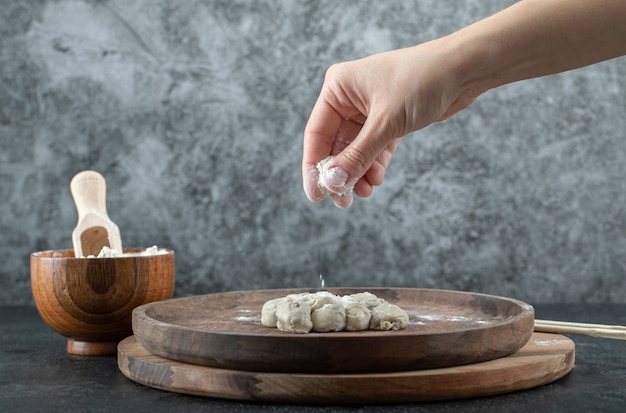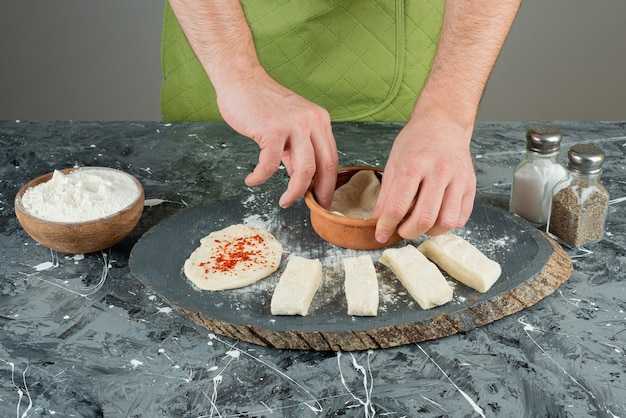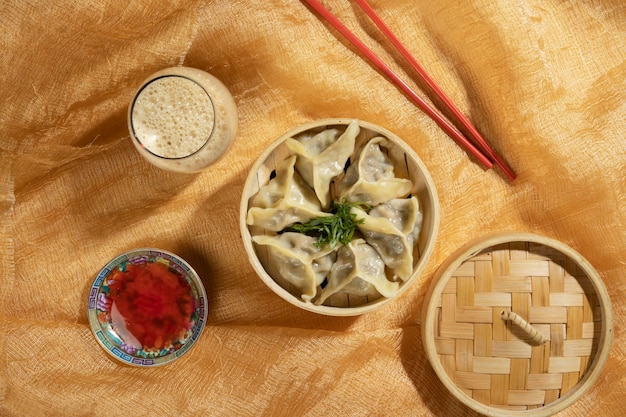Let me tell you, there's nothing quite like a plate of steaming hot dumplings. They're like little bundles of comfort food, filled with flavour and ready to melt in your mouth. But sometimes, the thought of making dumplings from scratch can seem a bit intimidating, especially if you're not a seasoned cook.
Don't worry! I'm here to guide you through the process, step by step, and by the end, you'll be a dumpling pro. I'll even share some of my personal tricks that I've picked up over the years. So grab your ingredients, put on your apron, and let's get started!
(Part 1) The Dough: The Foundation of Your Dumplings

1. The Secret to Perfect dumpling dough: A Simple, Flexible Recipe
The dough is the foundation of your dumplings, so let's get it right! I've tried all sorts of recipes, but this one is my absolute favourite. It's simple, flexible, and produces a dough that's wonderfully pliable and doesn't tear easily, which is key for creating those perfect, delicate dumplings.
Here's what you'll need:
200g plain flour, plus extra for dusting – This is your base, and a little extra flour is always handy for dusting your work surface.
1 tsp salt – A touch of salt enhances the flavour and balances the dough.
125ml boiling water – The key ingredient for a smooth, elastic dough.
2. Bringing the Dough to Life: A Quick and Easy Process
Now, this is where the magic happens. Combine the flour and salt in a large bowl. Make a well in the centre and slowly pour in the boiling water. Use chopsticks or a fork to stir the water into the flour. It's going to look a bit messy at first, but trust me, it'll come together beautifully.
The boiling water helps to create a smooth and elastic dough by activating the gluten in the flour. The steam from the water also creates a slightly cooked surface on the dough, which helps to prevent it from sticking together.
3. Kneading for a Smooth Finish: Achieving the Right Texture
Once the mixture has cooled down enough to handle, turn it out onto a lightly floured surface. Knead the dough for about 5 minutes until it's smooth and elastic. You want to be able to feel it firming up in your hands. If the dough is still a bit sticky, add a little extra flour, one teaspoon at a time.
Kneading is crucial for developing the gluten in the dough. This makes the dough more pliable and easier to work with, ensuring your dumplings hold their shape beautifully.
4. Resting for Maximum Flavor: Letting the Dough Relax
Cover the dough with a damp cloth and let it rest for at least 30 minutes. This allows the gluten to relax, resulting in a dough that's much easier to work with. While the dough is resting, you can prep your filling and get everything else ready.
This rest period is essential for a truly enjoyable dumpling experience. The gluten in the dough relaxes, making it more pliable and less prone to tearing.
(Part 2) The Filling: Choosing Flavors and Creating a Delicious Base

5. Choose Your Filling: Endless Possibilities
The beauty of dumplings is the endless variety of fillings you can use! I'm a big fan of classic pork and prawn filling, but you can get creative with vegetables, tofu, or even cheese and herbs. The possibilities are truly endless.
For this recipe, we'll go with a traditional pork and prawn filling. Here's what you'll need:
250g minced pork – The heart of the filling, offering a rich and savory base.
100g peeled and chopped prawns – Adding a delicate sweetness and a touch of seafood flavor.
1 tbsp finely chopped ginger – A subtle but essential ingredient that adds warmth and depth.
2 cloves garlic, minced – A punch of flavor that enhances the overall richness.
1 spring onion, finely chopped – Providing a touch of freshness and a subtle oniony flavour.
1 tbsp soy sauce – A savory and umami-rich ingredient that balances the other flavors.
1 tsp sesame oil – A nutty and aromatic oil that adds depth and complexity.
1 tsp cornstarch – Helps to thicken the filling and bind everything together.
Salt and pepper to taste – Adjust to your preference for a perfectly seasoned filling.
6. Mixing and Marinating: Blending Flavors for Maximum Deliciousness
In a large bowl, combine the minced pork, prawns, ginger, garlic, spring onion, soy sauce, sesame oil, and cornstarch. Mix everything well with your hands until the ingredients are evenly distributed. Season generously with salt and pepper.
The key is to get everything nicely mixed. Use your hands to really work the flavors together, ensuring a consistent and flavorful filling.
7. Let It Rest: Allowing the Flavors to Develop
Cover the bowl and let the filling marinate in the fridge for at least 30 minutes. This allows the flavors to meld and intensifies the taste. While the filling is marinating, it's a good time to clean your workspace and prepare your steamer.
This is an important step. The flavors of the filling will deepen and come together beautifully as the ingredients rest. This little bit of patience will be well rewarded.
(Part 3) Shaping the Dumplings: From Dough to Delicate Parcels

8. Dividing and Shaping: Transforming Dough into Dumpling Blanks
Now, the fun part! Divide the dough into 12 equal pieces. Roll each piece into a ball and flatten it slightly with your hand. Using a rolling pin, roll each ball into a thin circle, about 3-4 inches in diameter. If you're using a small rolling pin, it's perfectly fine to roll the dough in one direction first, then rotate it 90 degrees and roll again.
Rolling out the dough is a little like making pizza dough. You want to create a thin, even circle. Don't worry if your circles aren't perfectly round; a little imperfection adds to the charm of handmade dumplings.
9. Filling the Dumplings: Creating a Delightful Centre
Place a heaping tablespoon of filling in the centre of each circle. Bring the edges of the dough up around the filling and pinch them together to form a pleat. Continue pinching the edges together to create a neat little dumpling. You can use a fork to crimp the edges for a more decorative finish.
The key here is to seal the edges tightly to prevent the filling from spilling out during steaming. If you're feeling adventurous, you can try different pleating techniques for a visually appealing presentation.
10. Steaming to Perfection: The Final Touch for Tender Dumplings
Now, let's get those dumplings steaming! Line a steamer basket with a piece of parchment paper. Place the dumplings in the steamer basket, leaving a little space between each one. Bring a pot of water to a boil and then place the steamer basket on top. Cover the pot tightly and steam for 10-12 minutes, or until the dumplings are cooked through and translucent.
Steaming is the best way to cook dumplings because it creates a gentle and even heat, ensuring they cook perfectly and stay moist.
(Part 4) Serving and Enjoying: The Culinary Finale
11. The Grand Finale: Presenting Your Delectable Creations
Once the dumplings are steamed, remove them from the steamer and arrange them on a platter. Serve them hot with your favourite dipping sauce. I love a simple mixture of soy sauce, vinegar, and a dash of chilli oil, but you can also experiment with other sauces, like a sweet and sour dipping sauce or a spicy peanut sauce.
The possibilities for dipping sauces are endless. Experiment with different flavors and find what you enjoy most.
12. A Feast for the Senses: The Joy of Homemade Dumplings
The best part about dumplings is the experience itself. The anticipation as you watch them steam, the aroma that fills the air, and the satisfying crunch of the dough as you take your first bite. It's truly a sensory delight.
Take a moment to appreciate the effort that went into creating these delicious dumplings, and savour the moment as you enjoy them.
(Part 5) Tips and Variations: Mastering the Art of Dumpling Making
13. Tips for Success: Ensuring Dumpling Perfection
Use fresh, high-quality ingredients. This makes a huge difference in the flavour of your dumplings.
Don't overfill the dumplings. Too much filling will make them difficult to seal and can lead to them bursting during steaming.
Don't be afraid to experiment with different fillings. I love to play around with different flavour combinations, and you might be surprised at what you discover.
Keep the steamer basket lined with parchment paper. This prevents the dumplings from sticking to the bottom and makes for easier cleanup.
These tips will ensure that your dumplings turn out perfectly every time.
14. Variations on a Theme: Expanding Your Dumpling Horizons
Vegetable dumplings: Replace the pork and prawns with a mix of your favourite vegetables, such as cabbage, carrots, mushrooms, and chives. A healthy and flavorful alternative.
Tofu dumplings: Use firm tofu, crumbled, as a base for your filling and add in vegetables, herbs, and spices for a hearty and flavourful dish. A great option for vegetarian or vegan eaters.
Cheese and herb dumplings: For a more European twist, try using a mixture of ricotta cheese, spinach, and herbs like basil or oregano. A delightful and aromatic twist on a classic.
Feel free to explore your creativity and try different fillings.
(Part 6) FAQs: Answering Your Dumpling Questions
15. How do I know if the dumplings are cooked through?
The dumplings will be cooked through when they are translucent and firm to the touch. If you're unsure, you can pierce one with a toothpick. If the toothpick comes out clean, they're ready to eat.
16. Can I freeze dumplings?
Yes, you can freeze uncooked dumplings. Place them on a baking sheet lined with parchment paper and freeze them until solid. Then, transfer them to a freezer-safe bag or container. To cook frozen dumplings, simply steam them for a few minutes longer than you would fresh dumplings.
17. What are some other ways to cook dumplings?
While steaming is the most common method, you can also pan-fry, boil, or bake dumplings. Each cooking method produces a slightly different texture and flavor.
18. Can I make dumplings in advance?
Yes, you can make the dough and filling in advance. Just store the dough in the fridge, wrapped tightly in plastic wrap, and the filling in an airtight container. To assemble the dumplings, bring the dough to room temperature first.
19. What if my dough is too sticky or too dry?
If your dough is too sticky, add a little more flour, one teaspoon at a time. If it's too dry, add a tablespoon of water at a time until it's smooth and elastic.
These answers will help you solve any common dumpling-making challenges.
(Part 7) My Dumpling Journey: A Personal Reflection
20. A Fond Memory: A Culinary Milestone
I remember the first time I made dumplings from scratch. I was a little nervous, but I followed the recipe carefully and, to my delight, they turned out perfectly. My family loved them, and I felt so proud of myself for creating something so delicious.
This was a turning point in my culinary journey, and it instilled a love for this simple yet satisfying dish.
21. Learning and Growing: A Continuing Journey of Flavor
Over the years, I've learned so much about dumplings. I've experimented with different fillings, dough recipes, and even different ways of cooking them. But the most important lesson I've learned is that the best way to make dumplings is to enjoy the process. Whether you're cooking for yourself, your family, or your friends, making dumplings is a chance to connect with your inner chef and share something special with those you love.
This journey of discovery is ongoing. The world of dumplings is vast and full of flavor, and there's always something new to explore.
(Part 8) Beyond the Recipe: Exploring the Global Dumpling Landscape
22. A Global Culinary Journey: The Dumpling's Universal Appeal
Dumplings are a staple food in many cultures around the world. From the steamed buns of China to the gyoza of Japan and the pierogies of Poland, there are endless variations on this beloved dish. Each culture brings its own unique flavour and tradition to the table.
Dumplings are a testament to the universality of food. They are a source of comfort and connection across borders and cultures.
23. The Dumpling Experience: A culinary adventure
For me, making and eating dumplings is more than just a meal. It's an opportunity to travel the world through taste and to connect with different cultures. It's a reminder that food is a universal language that brings people together.
So, what are you waiting for? Gather your ingredients, put on your apron, and let's embark on a delicious journey together!
Everyone is watching

Prime Rib Roast Cooking Time Chart: Per Pound Guide
Cooking TipsPrime rib roast. Just the name conjures images of lavish dinners, crackling fires, and hearty laughter. It’s ...

How Long to Bake Potatoes in the Oven (Perfect Every Time)
Cooking TipsBaked potatoes are a staple in my kitchen. They're incredibly versatile, delicious, and surprisingly easy to m...

Perfect Rice Every Time: The Ultimate Guide to Cooking Rice
Cooking TipsAs a self-proclaimed foodie, I've always been a bit obsessed with rice. It's the foundation of countless cuisi...

The Ultimate Guide to Cooking Asparagus: Tips, Techniques, and Recipes
Cooking TipsAsparagus. The mere mention of this spring delicacy conjures up images of vibrant green spears, crisp and burs...

Ultimate Guide to Cooking the Perfect Thanksgiving Turkey
Cooking TipsThanksgiving. Just the word conjures up images of overflowing tables laden with delicious food, the scent of r...
